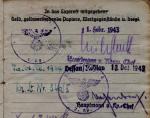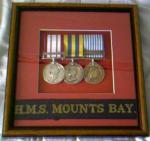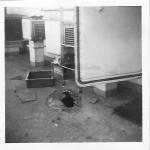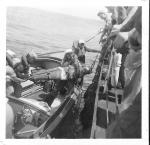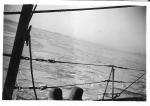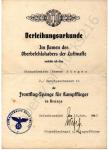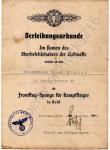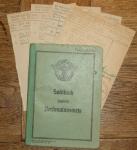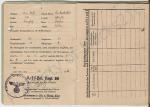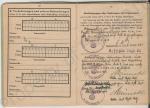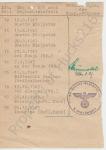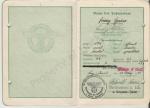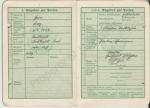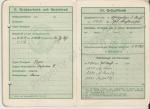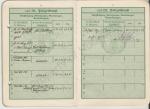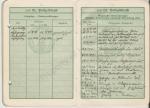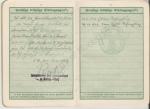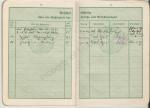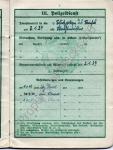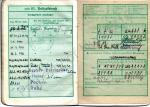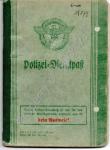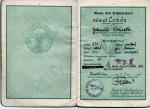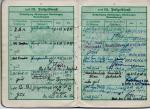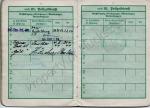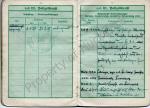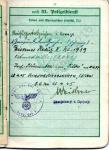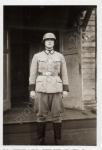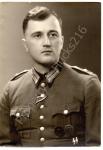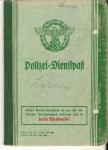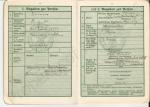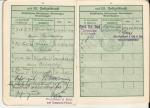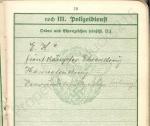-
Posts
3,680 -
Joined
-
Last visited
-
Days Won
9
Content Type
Profiles
Forums
Blogs
Gallery
Events
Store
Everything posted by hucks216
-

Heer 3 Pz Armee KVK2 & EK2
hucks216 replied to Jock Auld's topic in Germany: Third Reich: Research, Documentation & Photographs
They look to be very nice examples and a nice very late war EK citation. The Reinhardt signature looks correct for his one (I have his signature many times and it matches them all pretty much). The Manteuffel one looks different from the one I have from his 1944 GD days in that this one looks shorter (see the example in the Signature Database) but having said that I still think it is a good example. -
It is good that you have been able to keep hold of items belonging to your relative. I have seen similar citations - not SA related though as I don't really keep an eye out for SA stuff - and most units throughout Germany from youth organisations and upwards held many sporting & cultural events and issued citations for the first three winners in various competitions.
-
If you wish to display it then glass is a good way, as long as it is the type that can protect it from the sun's rays, otherwise an acid-free sleeve (although that would depend on the size obviously. But it has survived 70 years folded up and as long as it isn't folded and refolded constantly it should be ok for another few years yet. As for the bombing of Hannover, again taken from the Bomber Command War Diaries, it states that for the first raid visibility was good but stronger than forecast winds caused to the marking and bombing to be concentrated between 2-5 miles SSE of the city centre. For the second raid, again faulty forecast winds saved the centre of Hannover but the very concentrated bombing fell on an area 5 miles north of the city centre. Apparantly, RAF photographic data showed that most of the bombs fell in open country or in the villages north of the city.
-
That's an interesting piece of paper. There was a raid on Hannover on the night of the 22nd/23rd September which saw the loss of 31 aircraft from 7, 9, 10, 51, 57, 76, 77, 78, 90, 101, 102, 115, 158, 207, 214, 218, 428, 432, 434 & 460 Squadrons. An additional note of interest for that raid is that one of the aircrew shot down that night, F/O Pohe (RNZAF), went on to take part in The Great Escape in March 1944, was recaptured and was one of the 50 executed. The raid on the night of 27th/28th September was even more costly for the bombers with 48 aircraft being lost from 7, 10, 15, 35, 50, 51, 61, 75, 76, 77, 78, 90, 101, 103, 106, 149, 156, 158,166, 196, 199, 214, 218, 405, 428, 432, 434, 460, 620 & 622 Squadrons. (Source: RAF Bomber Command Losses Of The Second World War - 1943) The Bomber Command War Diaries states that 711 aircraft took part in the first raid, which was the first raid on Hannover in 2 years, and also saw 5 USAAF B-17's taking part in the first American night raid on Germany. It states that 26 aircraft were lost. Maybe the discrepancy is due to aircraft making it back to the UK but crashing on landing? For the second raid, the War Diaries book states that 678 aircraft took part in the raid with 38 being lost, including one B-17 (again, 5 USAAF B-17's participated).
-

Waffen SS SS Oberscharführer
hucks216 replied to Marcin L's topic in Germany: Third Reich: Research, Documentation & Photographs
Well I did think it could be SS-Aufkl.Abt 2 which belonged to Das Reich but with the 2 being at the front it is hard to be sure. What is it on - showing an image will be a big help? -

Waffen SS SS Oberscharführer
hucks216 replied to Marcin L's topic in Germany: Third Reich: Research, Documentation & Photographs
Chances are that unless he won any high end awards (which he didn't) or did something of note that it has been recorded in the unit history then it won't be possible to find anything out about him. His rank is that of an NCO. -
He might be mentioned in the unit histories for those units considering he held the DKiG if he was KIA. There are 3 Otto-Bernhard Schulze's listed in the Volksbund database. Two of them (one listed as a Soldat and the other as an Oberleutnant) may well be a duplicate entry due to the same date & place of birth & date of death and the date is before that of the DKiG. The only other one is listed as dying in a PoW hospital in Russia in 1946. That one gives no rank.
-

Wehrmacht Wehrmacht Prison Guard
hucks216 replied to dante's topic in Germany: Third Reich: Research, Documentation & Photographs
Nice example. I am surprised that it stayed on M321 for as long as it did. For some reason, while such WP's etc to staff members of punishment units are fairly scarce they don't seem to attract collectors in any great numbers. -
That's the first one of those I have seen that actually has a photo inside. Is there no listing on Page 23 that shows where and when he served? Obviously impossible to say for certain but a lot of these seem to have KvK (and in some cases EK's) entered for Operation Gomorrah, the RAF raids against Hamburg in the summer of 1943.
-
Any help in identifying these 3 signatures would be appreciated. They all belong to the same group for a soldier in Pionier units. The first is a signature on a citation for the soldier while he served in 1./Pz.Pi.Lehr.Btl 130 in 1944/45, while the second image is from his Soldbuch and is for when he served with 1 & 2./Pi.Lehr.Btl 4 in 1943. All ranks are Hauptmann.
-

The Korean War is NOT forgotten
hucks216 replied to azyeoman's topic in Modern Campaigns and Conflicts
Here are my dads medals from his Korean War service aboard HMS Mounts Bay (along with a medal for the Malayan Emergency) - and 3 photos taken from his photo album showing shell damage from coastal batteries, a wounded member of the ships company being medevac'd to USS Juneau and the sea ice. -
And here is the Soldbuch to Zugwachtmeister der Schutzpolizei Josef Pfaffenbichler who took part in the liquidation of the Bialystok Ghetto in 1943 while serving with SS-Pol.Rgt 26. This 'Aktion' is shown as an entry in the Campaign listing in the Soldbuch and also as 5 seperate entries on the Bandenkampftage sheet. The Yad Vashem Encyclopedia Of The Ghettos During The Holocaust Vol 1 – Pg 51... In mid-July 1943, the authorities in Berlin decided to liquidate the Bialystok ghetto and move its production facilities to the Lublin area. The ghetto had a population of 30,000 at this time and the decision to liquidate it was kept secret. On August 16th 1943, before daybreak, German soldiers, SS men and Ukrainian auxiliary forces under Georg Michalsen ringed the ghetto. In the ghetto streets posters printed in the name of the Judenrat urged all Jews to report to the ghetto gate for deportation. While most inhabitants heeded the call, a number went into hiding in bunkers and hideouts prepared in advance. German & Ukrainian forces spent the next five days systematically combing the ghetto and trapping thousands of fugitives. Between August 17th and 23rd 1943, more than 26,000 Jews were deported from the ghetto – some 7,600 to Treblinka, about 4,000 to Auschwitz-Birkenau and approximately 15,000 to labour camps in the Lublin district to which 5 ghetto factories were transferred as well. During the operation, hundreds of Jews were killed in and around the ghetto and some 300 patients in the hospitals were murdered. On August 24th about 1,200 children and 60 elderly Jews were deported to Theresienstadt; on 7th October 1943 they were subsequently deported to Auschwiz-Birkenau and murdered after a plan to swap them for German PoW’s fell through. The final liquidation of the ghetto was met with stiff resistance from the Jewish Underground but coming so soon after the Warsaw Ghetto Uprising, the Germans were in no mood to allow any resistance to gain ground and with brutal measures defeated the resistance within a number of hours. All the Jews, according to the deportation plan, had to be sent to Treblinka in five train transports. The transports, which included 76 freight cars, arrived in Treblinka on August 18 & 19th)( 3 of the transports passed through Treblinka heading to Auschwitz, Majdanek & Theresienstadt) The two transports from Bialystok were the last to arrive and be murdered in Treblinka. At that time the camp had already ceased to be fully operational. Part of it had been destroyed during the uprising a few weeks earlier and the number of Jews remaining in the camp to carry out the grim work had been greatly reduced so that the time taken to ‘process’ the Bialystok transports had been greatly increased. These difficulties were the reason why 2 of the other 3 transports were sent on to Majdanek & Auschwitz. It had always been part of the plan to send the children to Theresienstadt for the prisoner swap plan. The deportation & liquidation of the Jews from Bialystok was the last large-scale killing operation in which Globocnik and the Operation Reinhard staff were involved. Upon accomplishing this mission and in recognition of his work, Globocnik was promoted and appointed by Himmler as the Higher SS & Police Leader (HSSPF) in the Trieste area of northeast Italy. Between 11,000 to 15,000 of those deported to the Lublin area were murdered in November 1943 during the Aktion known as Erntefest (Harvest Festival). And from another (forgotten) source.... August 16, 1943: Bialystok Ghetto; Deportations begin again. (Final liquidation of the Ghetto.) At Himmler's orders, families are separated. The usual procedures of selection commence. Many Jews were shot and beaten throughout the process. There would be no repeat of the resistance experienced in the Warsaw Ghetto. Bialystock would be emptied of Jews from this time on. August 17, 1943: Bialystok; The latest deportation continues. 1,200 children are selected for transport first to Theresienstadt. Four weeks later, those children still alive were sent to Birkenau where all of them met the fate of death. 53 Adults volunteered to join them. August 18, 1943: Bialystok; Thousands of more Jews are deported to Treblinka. The last train to ever be sent there again. All the Jews were sent to the gas chambers. Afterwards, the camp closed down for good. After the Ghetto Aktion, in September 1943 SS-Pol.Rgt 26 operated against the partisans of the Kolpak Brigade in the Zamosc area before taking part in Operation Heinrich in Oct-Nov 1943 between Nevel & the Latvian border. For the final month of 1943 it took part in Operation Otto and advanced from both sides of Zebezh and aimed to push south to the Dvinsk-Polotsk rail line. In January 1944 as part of Polizei-Kampfgruppe ‘Jeckeln’ it deployed with the 263 Infantry Division. Josef Pfaffenbichler was killed in action in January 1944.
-
I'll show some scans from one of the remaining Dienstpaß and the Soldbuch. This Dienstpaß belonged to Oberwachtmeister der Schutzpolizei Franz Hain who served with Pol.Btl 322 and then Pol.Rgt 5. With the former he took part in the massacres at Bialystok in July 1941 and Mogilev in October 1941.. Taken from The Yad Vashem Encyclopedia Of The Ghettos During The Holocaust Vol 1 – Pg 50 and Pg 492... Bialystok July 1941 On July 8th 1941, SS chief Heinrich Himmler, visiting Bialystok in the company of Kurt Daluege, ordered the execution of 2,000 Jews as a punishment for the Jews’ alleged participation in looting. On July 12th, members of Police Battalions 316 & 322 concentrated approximately 4,000 Jewish men in the municipal stadium. The following day, the men were murdered in groups in the Pietrasze Forest. By the end of the month the Bialystok Ghetto was established containing 43,000 Jews. Mogilev October 1941 On October 2nd/3rd 1941, members of Einsatzkommando 8 (Einsatzgruppe B) and Police Battalion 322, aided by local police, murdered 2,270 Jews from the Mogilev Ghetto outside the nearby village of Kazimirovka. In a second operation on October 17 – 19th Police Battalion 316, aided by Belarussian police murdered some 3,700 Jews near the village of Polykhovichi. The Ghetto was finally liquidated on October 23rd 1941. Taken from Pol.Rgt Mitte Kriegstammbuch.. 1st August 1941 – Pol.Btl 322 shot 72 Jews in a creek outside Bialowieza 31st August 1941 - 7. and 9 Company (2 & 3 Kompanie Pol.Btl 322) drove through Jewish actions in Minsk. Here, about 700 Jews, including 54 women were arrested and taken to the prison of Minsk 1st September 1941 – 9 Kompanie (3 Komp./Pol.Btl 322), along with the SD & NSKK shoot 914 Jews outside Minsk, including 64 Jewish women. Among these are the 700 Jews who were rounded up on 31st August. The 64 Jewish women were shot as they were found to be without the Yellow Star during the round-up. 2nd October 1941 – From 1530 9 Kompanie is in the Mogilev Ghetto together with senior staff of HSSPF Russland-Mitte & Ukrainian Aux.Police. 2,208 Jews rounded up. 65 shot ‘while trying to escape’. 3rd October 1941 – 7 & 9 Kompanie, along with senior staff of HSSPF Russland-Mitte, execute 2,008 Jews in the forest outside Mogilev. The signature of Hptm Gerhard Riebel seen in the Dienstpaß shows that this man served in 3./Pol.Btl 322. SS-Pol.Rgt 5 was established in Slovenia in July 1942 from Pol.Btl’s 64, 322 and a newly raised III Btl made up of ethnic Germans. Between June 1942 and January 1943 it took part in two major operations, Operation Enzian in Slovenia in 1942 and in an operation against partisans in Mitrovica along with the Bulgarian 24th Division and Serbian Volunteer Corps.
-
Oberst Hermann Busch. Fliegerführer Nord (Ost) Fliegerführer Nord (West) Fliegerführer Eismeer DKiG (24-11-1941) / Ehrenpokal (15-05-1941) Image: LW Citation
-
I have a number of Dienstpasse. Including the ones you have seen I have... III/SS-Pol.Rgt 23 at Warsaw Ghetto Uprising in 1943 & Warsaw Concentration Camp Guard. KIA on first day of the 1944 Warsaw Uprising. Pol.Btl 103 1./Pol.Btl 303 at Babi Yar 3./Pol.Btl 322 & 7./Pol.Rgt 5 with the former at Bialystok & Mogilev Ghetto massacres in 1941 Pol.Btl 121 & Schuma Btl 60 Pol Btl 308 & 2./Pol.Btl 307- KIA 9th May 1942. and the only Polizei Soldbuch I have... 8./SS-Pol.Rgt 26 at the liquidation of the Bialystok Ghetto in 1943. Comes with his Sturmtage, Nahkampftage & Bandenkampftage sheets clearly showing he was at the liquidation of the Ghetto.
-
Here is one to an eventual San-Oberwachtmeister in the Schutzpolizei who served with many units, the main two being Res.Pol.Btl 121 from March 1940 to August 1942 and Schuma Btl 60 from March to June 1944. After tat there are no further entries so it is possible that he was enlisted into 30 Waffen-Grenadier Division der Waffen-SS (Russische Nr 2) which Schuma Btl 60 was absorbed into. It fought the FFI in France but suffered with low morale problems which saw 2 mutinies with many German officers & NCO's being murdered by the soldiers. Helmut Conde was decorated many times, being awarded the Wound Badge in Black & Silver (last wound was in October 1944), EK II, Ost Front Medal, Infantry Assault Badge in Silver and a Sports Award.
-
Here are some scand for the Pol.Btl 103 Dienstpaß, and some history of their actions in Poland... The Invasion of Poland in 1939 and the first police operations in Poland in 1939/40 A total number of 17 Police Battalions, stationed as active police, were deployed within the framework of the army high command (Armeeoberkommando (AOK)), in the invasion of Poland. These 17 police battalions were organized into six police groups, three Hamburg police battalions being among them: (I/2, II/2, III/3, later 101, 102, 103), within police group 2, under army high command 10 (AOK 10). The three battalions, each with battalion staff and four companies, were assembled on 1.09.1939, and transported to Poland on 6.09.1939. They were preliminarily posted to Kielce, Tomaszow and Konskie. They were then transported by train to Breslau, and from there to Tschenstochau by Hamburg buses. All three battalions accompanied or followed the advance of the units of AOK 10. During this phase of the war the police battalions were active in the repressive measures taken against the civil population, including executions following drumhead court-martials held by the army, the SS or police, in combat against the Polish regular army, the guarding of prisoners of war, the support of units of the SS and SD (SS Security Service), the gathering of weapons, and in the "resettlement" of the native population ("Umsiedlungsaktionen"). This "Umsiedlungsaktionen" also involved the eviction of Poles and Jews from the areas within the "Generalgouvernement", e.g. from the "Warthegau", annexed to the German Reich. And so in October 1939, Police Battalion 103, among others, was transferred to Poznan (Posen), and took part in the expulsion of the civil population from the town and surrounding countryside. Numerous killings were carried out during this operation, as indicated by testimony given in later preliminary proceedings. These killings mostly took place when expelling people from their accommodation under orders from an SS Junker. Numerous elderly people were murdered, under orders, on the spot, to spare them the strain of the transport ("Belastung des Transport"). The German judiciary later regarded this involvement in the "resettlement" ("Umsiedlung"), when at all, as "wrongful deprivation of personal liberty" ("Freiheitsberaubung"), and judged it as coming under the statute of limitations (the legislative enactment prescribing the period of time within which proceedings must be instituted to enforce a right or bring an action at law), and therefore not sentenceable.




